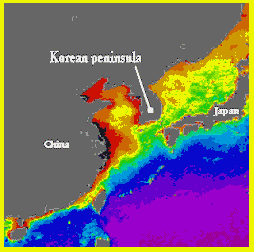|
Hot Issues in Korea's Cool Waters |

|
|
Like much of the northern hemisphere, Korea's waters are highly productive - but nothing lasts forever .
"Productivity" simply means how much living stuff (biomass) is produced by a particular region. Satellites can measure productivity using characteristics of the sea's surface. The image below has been created by the SEAWIFS project from satellite data: |
|

|
The satellite has measured the concentration of chlorophyll (the green parts of plants) in the waters of Korea, Japan & China.
The red colours on the map show the areas of highest productivity - the tidal flats of Korea's west coast and similar areas on China's eastern coast.
The plants in the water include seaweeds (algae), but most of them are microscopic plants called phytoplankton.
|
|
Because these waters are so productive, Korea's tidal flats are important food collection areas for many Koreans.
But experience in other cool seas - and common sense - suggests that there must be a limit to the productivity of these waters.
Some of the productivity-related issues facing Korea's cool waters include: |
|
Land Reclamation
Fisheries Management
Introduced Marine Pests
Marine Reserves
Aquaculture

|

|
|
Strings of ojingo (squid) drying in the sun.
Squid are the largest commercial catch of molluscs in Korea, but the sustainable harvest levels of these animals and other seafood remain unknown. Photo courtesy of Je Jong-Geel. |
|
Back to our clickable map or find the SEAWIFS project via our links. |
|

The satellite image on this page is used with the kind permission of the NOAA SEAWIFS project. Please visit the SEAWIFS project via our links page.
|